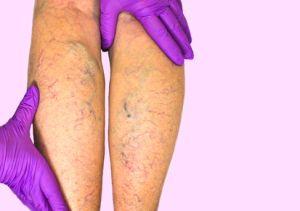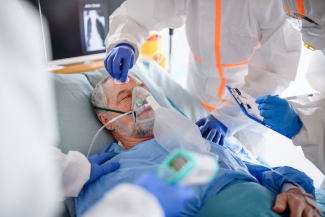The Challenge of Lower Extremity Wounds – Venous Stasis Ulcers, Part 1
April 20, 2017
Part 1 of a series discussing the assessment and management of lower extremity wounds.
Wound clinicians across the nation (and the world) are commonly faced with the difficult task of managing lower extremity wounds. Lower extremity wounds come in many different forms. We are not faced with a generic type, but several—in fact, we never know what we'll be presented with day-to-day.
Lower extremity wounds vary, and the underlying factor or origin may be that of venous, arterial, at times mixed (venous and arterial), and the famous DFU (diabetic foot ulcer)… And these three are just the main types we encounter. There are other types of lower extremity wounds, such as vasculitic, traumatic, lipedema, and sickle cell anemia related, as well as atypical wounds and even rare diseases like polycythemia vera, among others. In this post, we will tackle the famous venous stasis ulcers and break down etiology, assessment, risk factors, characteristics, diagnostics, and treatment.
Venous leg ulcers have a worldwide prevalence of 1-1.3%, and 3.5% of people over the age of 65 have venous ulcers - with that number continuing to rise. Clinicians are challenged with etiological factors, treatment, and with management of peripheral vascular disease. In an effort to decrease the rate of recurrence, a continued treatment plan of compression after the wound or wounds have healed is necessary.
A common location for stasis ulcers is on the ankle, medial aspect, sometimes circumferential, and the site may also be referred to as the gaiter area of the leg - the area between the knee and the ankle. Stasis refers to a stoppage or slowdown in the flow of blood. So, let's continue to explore system overview, etiology, risk factors, characteristics, diagnostics, goals, and treatment.
System Overview and Pathophysiology of Venous Stasis Ulcers
There are two types of veins in the human body: the deep veins that carry most of the blood back to the heart, and the superficial veins that carry blood under lower pressure. The deep veins and superficial veins are connected via perforators or perforating veins. Inside our veins (deep, superficial, and perforating), we have valves that are unidirectional and assist in preventing backflow. So, blood flows to our lower extremities through our venous system, and the calf muscle plays an intricate part, with valves open allowing the passage of blood, and valves closed to prevent any regurgitation of blood – in the same manner as blood pushes up to the heart. Calf muscles, as they contract, force blood to move towards the heart. Activities, such as walking or running, activate the calf muscle pump, which results in a drop in pressure in our deep venous system that facilitates the movement of blood from superficial to deep veins via a series of communicating veins (perforators). Damage to the calf muscle pump leads to reflux, venous hypertension, varicose veins, acute and chronic lipodermatosclerosis, and ultimately, venous ulcers.
Other predisposing factors for venous ulcer development include: fibrin-cuff theory, white cell trapping theory, prior pregnancies, deep vein thrombosis, heart failure, congestive heart failure, diabetes, paralysis with muscle weakness, obesity, valve dysfunction, poor nutrition, standing professions, family history, advanced age, post-thrombotic syndrome, leg trauma, and unfortunately for women, it is more common than in men.
Assessment of Venous Stasis Ulcers
Normal ankle-brachial index (ABI): exceedingly low ABI will indicate arterial compromise, with further testing needed. ABI that is too high indicates calcified vessels, more commonly found within individuals with diabetes, and therefore non-compressible due to potential damage compression may cause. Other signs to look for in your venous ulcer assessment include:
- Venous dermatitis
- Evidence of healed ulcers – scarring
- Varicose veins
- Skin changes, itching, erythema, scaling pruritus
- Insidious onset of edema, pitting or non-pitting
- Heavy and aching leg
- Lipodermatosclerosis, skin changes to leg (dermal and subcutaneous tissues), induration, inflammation and erythema, hyperpigmentation
Characteristics of Venous Stasis Ulcers
When assessing patients with lower extremity wounds, it's all about location, location, location. Typically, venous leg ulcers develop on the medial lower leg, above the medial malleolus, gaiter area and may be circumferential. Other characteristics of the venous ulcers include:
- Superficial to deep wounds, usually full-thickness
- Ruddy, granular tissue
- Moderate to heavy exudates, high incidence of underlying fungus of skin and usually heavily contaminated
- Periwound with venous flare, atrophie blanche (white plaques), maceration, hemosiderin staining, crusty
- Undermining and tunneling are not common
- Irregular wound margins, inverted champagne bottle appearance
Diagnostics
Several diagnostic tools can be used in assessment venous leg ulcers. They include:
- Duplex ultrasonography – establishes the presence or absence of venous reflux and obstruction
- Ankle-brachial index (ABI) – determines difference in blood pressure between upper and lower extremities, less than 0.6 is abnormal and correlates with arterial insufficiency; compression is contraindicated until further arterial testing is done to confirm diagnosis
- Duplex scan – locates venous reflux in the superficial, deep, and perforating veins
- Photoplethysmography – measures vascular volume and competence with infrared light
- Radionuclide venography – assessment of venous system utilizing radiopharmaceutical technetium 99; other tests are also available
Venous Ulcer Treatment Goals
Compression is the "Gold Standard." Assess for the best type of compression for patient, rigid or elastic. Rigid refers to Unna's boot (patient must be ambulatory), composed of gauze impregnated with calamine, and zinc oxide paste, which is wet on application and will dry and become rigid for more effective calf muscle pump response on ambulation, resulting in removal of excess fluid. There are also short bandages, graduated compression stockings, four-layer compression, and mechanical pumps.
Congestive heart failure is the only contraindication for compression and treatment of venous ulcers, but consider compressing one leg with full compression and the other with light compression, alternate with dressing changes, and closely monitoring the patient. Treatment of venous stasis ulcers requires a multifaceted approach:
- Management of barriers to healing, including edema
- TIME – removal of non-viable tissue, management of infection and inflammation – bacterial load and moisture balance
- Protection of periwound tissue
- Moisturization of skin under compression
- Topical wound care and overall wound management
- Leg elevation
- Cooperation of patient with medications, DM control, and exercise as tolerated
- Other treatment may include cellular and/or tissue-based products for wounds, growth factors, venous repair surgery, grafting, use of NPWT alone or to bolster graft, and systemic as well, with use of pharmacotherapy at the discretion of the MD.
To Compress or Not to Compress… That is the Question
Overall wound management is essential for the identification and treatment of venous stasis ulcers. The involvement of the SWAT team will always be a matter of best practice. I will not get tired of saying it: IT TAKES A VILLAGE. We need the cooperation, involvement, recommendations, and direction of the SWAT team in order to correctly identify the etiology, and make sure it is not of mixed or arterial etiology before we shout COMPRESS, IT'S THE GOLD STANDARD! Education is key! Consistency in using and practicing our guidelines correctly will result in a faster healing time, cost-effectiveness, and reduce unnecessary infections or hospitalization of our patients.
Keep healing my friends!!!
Author's Note: This blog post is dedicated to the most unselfish man I ever met. In memory of my friend Jon Massey, until we meet again, my friend...
References:
Clinical Guide Wound Care, fourth edition (Cathy Thomas Hess) p.63-71
Scottsdale Wound Management Guide – A comprehensive guide for the wound care clinician (Livingston and Wolvos) p.32-44
Wound Care Certification Study Guide (J.B. Shah) ch. 14, p.115-120
WOCN Clinical Fact Sheet – Venous Insufficiency
About the Author
Martin Vera is a certified wound specialist with over 19 years of nursing experience, with a passion for wound management and patient-centered care.
The views and opinions expressed in this blog are solely those of the author, and do not represent the views of WoundSource, HMP Global, its affiliates, or subsidiary companies.












Follow WoundSource
Tweets by WoundSource